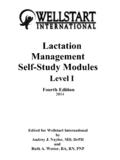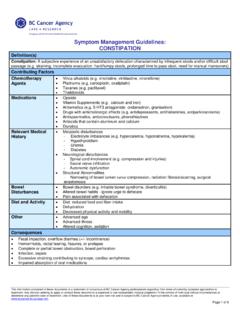Transcription of FACT - Occupational Safety and Health Administration
1 Common Beliefs vs. Facts About Safe Patient Handling Programs Mechanical lifting is not as safe and comfortable for patients as manual lifting. FAC T: Once patients realize the ease and comfort of modern mechanical lifts, they will be more likely to accept them. Mechanical lifts are safer for both patients and healthcare workers. Training and use of proper body mechanics (including use of back belts) is effective in preventing job-related injuries. FAC T: Research shows that relying on proper body mechanics (including use of back belts) is not, by itself, an effective way to reduce injuries. There is no such thing as safe manual lifting of a patient. You don t need to worry about patient-handling injuries if your workers are healthy and never had a problem.
2 FAC T: Manual lifting can cause micro-injuries to the spine. Although workers may not feel the effects immediately, cumulative micro-injuries can result in a debilitating injury. Experts recommend that lifts be limited to 35 pounds or less. Good Health and strength may actually put workers at increased risk because their peers are much more likely to seek their assistance when manually lifting patients. It is much faster to manually move patients. FAC T: If equipment is located conveniently, accessing it will not take a long time. It is often more time-consuming to round up a team of workers to manually lift a patient than to get safe patient handling equipment. Manual lifting is less expensive than mechanical lifting.
3 FAC T: Costs associated with back injuries in the healthcare industry are estimated to be $20 billion annually. Research shows the use of assistive technology such as mechanical lifts reduces injuries to workers and lowers costs associated with workers compensation, lost productivity, and turnover. record serious injuries and illnesses that are work-related and meet other general criteria on the OSHA 300 Log. Information from the 300 Log and the 301 form can be used to identify tasks and jobs with higher risks of injury, to monitor trends and to gauge the effectiveness of intervention efforts. Whistleblower ProtectionsUnder the Occupational Safety and Health Act employees may not be retaliated against for reporting a work-related injury or illness (29 660(c)).
4 Employers must ensure that no employee is discriminated against for exercising his or her rights, including reporting potential hazards, symptoms or work-related Free OSHA On-site Consultation Program: A Valuable Resource for Implementing a Safe Patient Handling ProgramThrough the OSHA On-site Consultation Program, OSHA provides free and confidential Safety and Health advice to small and medium-sized businesses committed to improving workplace Safety and Health . On-site consultation services are separate from enforcement and DO NOT result in penalties or citations. Additional Resources: yOccupational Safety and Health Administration yNational Institute for Occupational Safety and Health yThe Veterans Health Administration yThe Joint Commission yService Employees International Union (SEIU) yAmerican Nurses Association ; Patient HandlingPreventing Musculoskeletal Disorders in nursing HomesFor more information on safe patient handling legislation in states and other resources, visit 3708 - 02/2014 Under the OSHA law, employers have the responsibility for providing a safe and healthful workplace for their workers.
5 Workers have the right to working conditions that do not pose a risk of serious harm. For questions, or to get information or advice, to order publications, or to file a confidential complaint, contact OSHA at 1-800-321-OSHA (6742), or go to InjuriesNurses and other healthcare workers face many Safety and Health hazards in their work environments. In fact, healthcare workers experience some of the highest rates of non-fatal Occupational injuries and illnesses of any industry 2012, injuries and illnesses reported for nursing and residential care workers were significantly higher than those in construction, and 2-3 times higher than in retail or manufacturing. Almost half of the injuries and illnesses reported for nurses and nursing support staff were musculoskeletal disorders (MSDs).
6 Rates of MSDs for nursing assistants ( ) were almost four times as high as the average for all workers ( ). MSDs affect the muscles, nerves and tendons. Work-related MSDs (including those of the neck, upper extremities and low back) are a leading cause of lost workday injuries and illnesses for healthcare and social assistance workers, particularly in nursing homes and residential care facilities. Examples of MSDs include muscle strains and low back injuries, rotator cuff injuries (shoulder problems), and has identified that the risk factors for MSDs include the repeated and forceful movements associated with patient care such as lifting, transferring, and repositioning. Work-related MSDs can be prevented. Safe patient handling programs employ the use of mechanical equipment and other elements to reduce the number and severity of work-related of Safe Patient Handling Safe patient handling programs reduce the risk of injury for both healthcare workers and patients while improving the quality of patient care.
7 Use of lifting equipment is essential to a successful safe patient handling program and has been shown to reduce exposure to manual lifting injuries by up to 95%.In addition to reducing healthcare worker injuries and related lost work time, safe patient handling programs have other benefits, including: yMore satisfying work environment and professional status; yImproved nursing recruitment and retention; yIncreased patient satisfaction and comfort; yDecreased patient falls and pressure ulcers; and yReduced costs associated with of a Successful Safe Patient Handling ProgramThe elements of a successful safe patient handling program include:Commitment from management at All Levels: Gaining management support, as well as assembling a team for a safe patient handling program, are critical to program success.
8 management can provide visible support by consistently communicating the importance of safe patient handling; assigning roles for various aspects of a safe patient handling program to appropriate managers, supervisors, and other employees; and providing appropriate resources for implementing and sustaining the program over time. A Safe Patient Handling Committee that Involves Frontline Workers: To design and implement a safe patient handling program, as well as to evaluate and sustain the program into the future, the frontline (non-managerial) employees who provide direct care to patients should be well-represented on the safe patient handling Assessment: Address high-risk units, areas, and patient-handling tasks.
9 Hazard evaluation should consider factors such as types of nursing units, the physical environment of patient care areas, and existing equipment and its utilization. It is important to consider characteristics of the patient population such as level of patient mobility and & Prevention Through Design: Implement methods to control hazards such as lifting, transferring, and repositioning patients. Manual lifting should be minimized in all cases and eliminated when feasible. For example, a zero-lift program or policy minimizes direct patient lifting by using specialized lifting equipment and transfer tools. Establish safe patient handling policies that are based on patients physical and medical conditions and the availability of lifting equipment and lift teams.
10 Select appropriate lifting equipment in accord with the hazard assessment, and install and maintain lifting devices according to manufacturer recommendations. The best proactive approach is through proper design of the work environment, including incorporating Health hazard controls into the design of facilities during construction and remodeling. Education & Training: Provide sufficient education and training so that each worker understands the elements of the safe patient handling program and how to participate. The education and training of healthcare workers should be geared toward the assessment of hazards, selection and use of the appropriate patient lifting equipment and devices, and review of evidence-based practices for safe patient handling.
















